Discover 35 hidden attractions, cool sights, and unusual things to do in Vilnius (Lithuania). Don't miss out on these must-see attractions: Vilnius Castle Complex, Presidential Palace, and Verkiai Palace. Also, be sure to include Gate of Dawn in your itinerary.
Below, you can find the list of the most amazing places you should visit in Vilnius (Vilniaus).
Table of Contents
Vilnius Castle Complex

Also known as: Gedimino pilis
The Vilnius Castle Complex is a group of cultural, and historic structures on the left bank of the Neris River, near its confluence with the Vilnia River, in Vilnius, Lithuania. The buildings, which evolved between the 10th and 18th centuries, were one of Lithuania's major defensive structures.
The complex consisted of three castles: the Upper, the Lower, and the Crooked (Lithuanian: Kreivoji pilis). The Crooked Castle was burned down by the Teutonic Knights in 1390 and was never rebuilt. The Vilnius Castles were attacked several times by the Teutonic Order after 1390, but they did not succeed in taking the entire complex. Its complete capture occurred for the first time during the 1655 Battle of Vilnius. Soon afterwards, the severely damaged castles lost their importance, and many buildings were abandoned. During the Tsarist annexation, several historic buildings were demolished; many more were damaged during the fortress construction in the 19th century.
Today, the remaining Gediminas Tower is a major symbol of the city of Vilnius and of the nation itself. Annually, on 1 January, the Lithuanian tricolor is hoisted on Gediminas Tower to commemorate Flag Day. The complex is part of the National Museum of Lithuania, one of the largest museums in the country.[1]
Address: Arsenalo g. 5, Vilnius
Presidential Palace
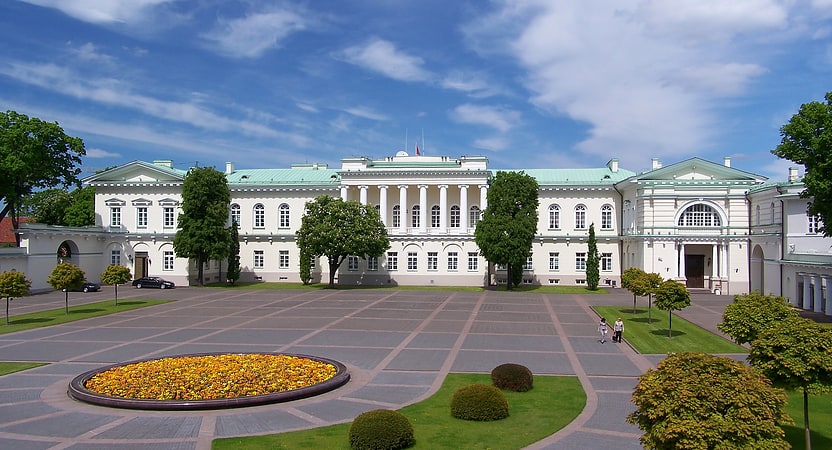
Also known as: Lietuvos Respublikos prezidentūra
Presidential palace in Vilnius, Lithuania. The Presidential Palace, located in Vilnius Old Town, is the official office of the President of Lithuania. The palace dates back to the 14th century and during its history it has undergone various reconstructions, supervised by prominent architects, including Laurynas Gucevičius and Vasily Stasov. In 1997 the palace became the official seat of the President of Lithuania.[2]
Address: Daukanto aikste 3/8, Vilnius
Verkiai Palace

Also known as: Verkių dvaras
Mansion in Vilnius, Lithuania. Verkiai Palace is an 18th-century neoclassical mansion in Verkiai, Vilnius, Lithuania.[3]
Address: 49 Žaliųjų Ežerų g, Vilnius
Gate of Dawn
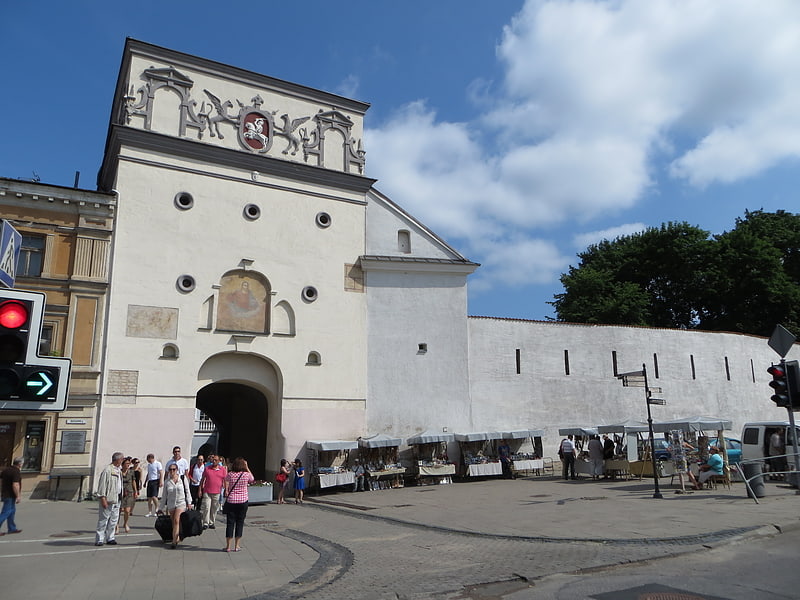
Also known as: Aušros vartai
16th-century city gate and religious site. The Gate of Dawn, or Sharp Gate is a city gate in Vilnius, the capital of Lithuania, and one of its most important religious, historical and cultural monuments. It is a major site of Catholic pilgrimage in Lithuania.[4]
Address: Aušros Vartų g. 14, 01303 Vilnius
Church of St. Peter and St. Paul
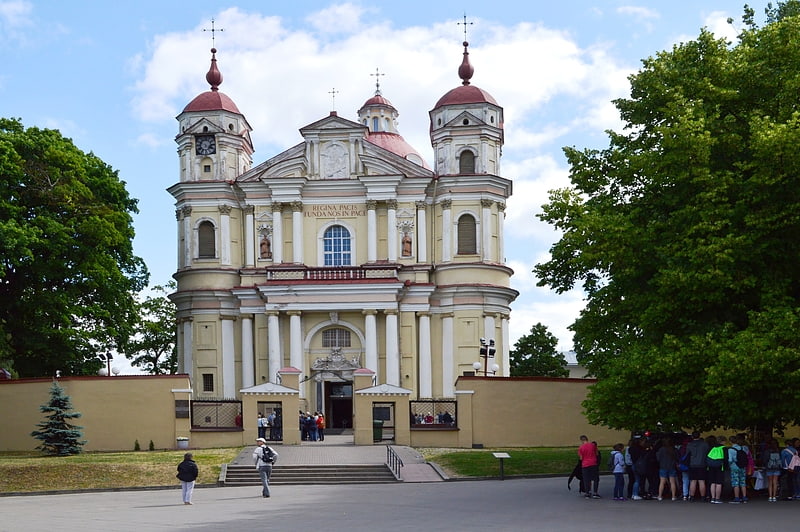
Also known as: Vilniaus Šv. apaštalų Petro ir Povilo bažnyčia
17th-century baroque Catholic church. The Church of St. Peter and St. Paul is a Roman Catholic church located in the Antakalnis neighbourhood of Vilnius, Lithuania. It is the centerpiece of a former monastery complex of the Canons Regular of the Lateran. Its interior has masterful compositions of some 2,000 stucco figures by Giovanni Pietro Perti and ornamentation by Giovanni Maria Galli and is unique in Europe. The church is considered a masterpiece of the Polish–Lithuanian Commonwealth Baroque. It was funded by Michał Kazimierz Pac, commemorating a victory over the Muscovites and their expulsion from Vilnius after six years of occupation.[5]
Address: Antakalnio g. 1, 10312 Vilnius
Rasos Cemetery
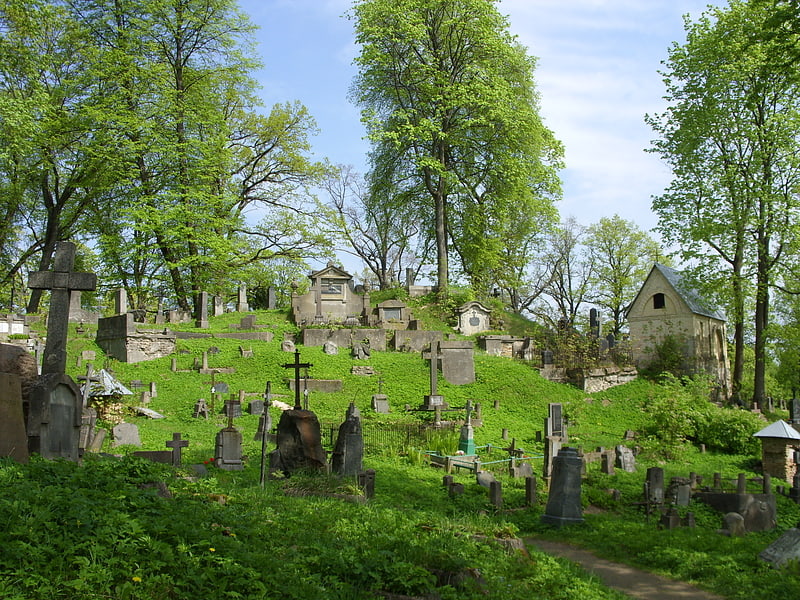
Also known as: Rasų kapinės
Cemetery in Vilnius, Lithuania. Rasos Cemetery is the oldest and most famous cemetery in the city of Vilnius, Lithuania. It is named after the Rasos district where it is located. It is separated into two parts, the old and the new cemeteries, by a narrow Sukilėliai Street. The total area is 10.8 ha. Since 1990 new burials are allowed only to family graves.[6]
Address: Rasų g. 32, Vilnius
Vilnius Cathedral
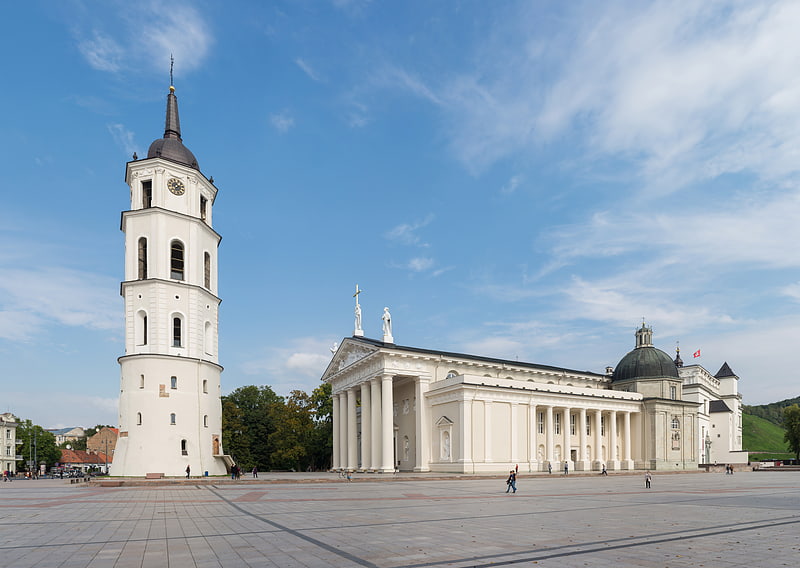
Also known as: Vilniaus Šv. Stanislovo ir Šv. Vladislovo arkikatedra bazilika
Restored, classical Catholic cathedral. The Cathedral Basilica of St Stanislaus and St Ladislaus of Vilnius is the main Roman Catholic Cathedral of Lithuania. It is situated in Vilnius Old Town, just off Cathedral Square. Dedicated to Saints Stanislaus and Ladislaus, the church is the heart of Catholic spiritual life in Lithuania.
The coronations of the Grand Dukes of Lithuania took place within its confines. Inside its crypts and catacombs are buried many famous people from Lithuanian and Polish history including Vytautas (1430), his wife Anna (1418), his brother Sigismund (Žygimantas) (1440), his cousin Švitrigaila (1452), Saint Casimir (1484), Alexander Jagiellon (1506), and two wives of Sigismund II Augustus: Elisabeth of Habsburg (1545) and Barbara Radziwiłł (1551). The heart of the Polish king and Grand Duke of Lithuania Władysław IV Vasa was buried there upon his death, although the rest of his body is buried at the Wawel Cathedral in Kraków.
Inside, there are more than forty works of art dating from the 16th through 19th centuries, including frescoes and paintings of various sizes. During the restoration of the cathedral, the altars of a presumed pagan temple and the original floor, laid during the reign of King Mindaugas, were uncovered. In addition, the remains of the cathedral built in 1387 were also located. A fresco dating from the end of the 14th century, the oldest known fresco in Lithuania, was found on the wall of one of the cathedral's underground chapels.
During the Soviet regime initially the cathedral was converted into a warehouse. Masses were celebrated again starting in 1988, although the cathedral was still officially called "The Gallery of Images" at that time. In 1989, its status as a cathedral was restored.[7]
Address: Katedros a. 1, 01013 Vilnius
Raduškevičius Palace
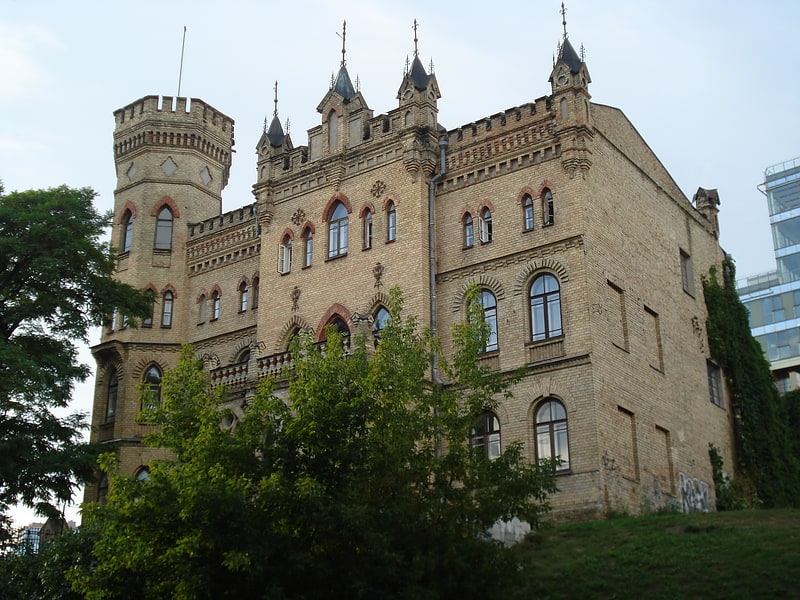
Also known as: Raduškevičiaus rūmai
Building in Vilnius, Lithuania. The Raduškevičius Palace is a building in Vilnius, Kalvarijų st. 1. Currently it is headquarters of the Lithuanian Architects Union.[8]
Three Crosses
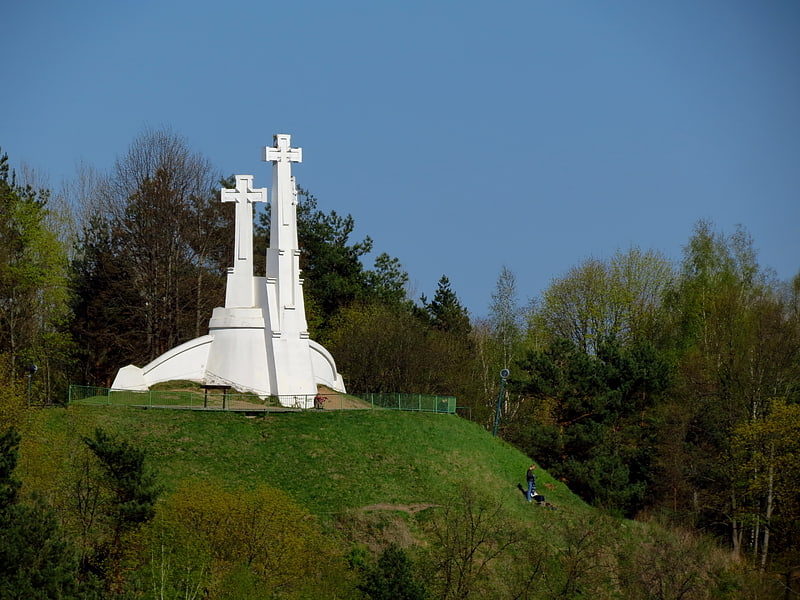
Also known as: Trijų Kryžių paminklas
Historic monument with city views. Three Crosses is a prominent monument in Vilnius, Lithuania, on the Hill of Three Crosses, originally known as the Bald Hill, in Kalnai Park. According to a legend, which finds its source in some historic events, seven Franciscan friars were beheaded on top of this hill. Wooden crosses have been sited in the location since the early 17th century, and they became a symbol of the city and an integral part of the city's skyline.
As the wood rotted, the crosses needed to be periodically replaced. In 1916, a concrete monument was designed by Polish–Lithuanian architect and sculptor Antoni Wiwulski or Antanas Vivulskis in Lithuanian. It was torn down in 1950 by order of the Soviet authorities. A new monument designed by Henrikas Šilgalis was erected in its place in 1989. The monument was depicted on 50 litas banknote. A panorama of the Vilnius Old Town can be observed from a small observation deck at the base of the crosses.[9]
Address: T.Kosciuškos gatvė, Vilnius
Vilnius TV Tower
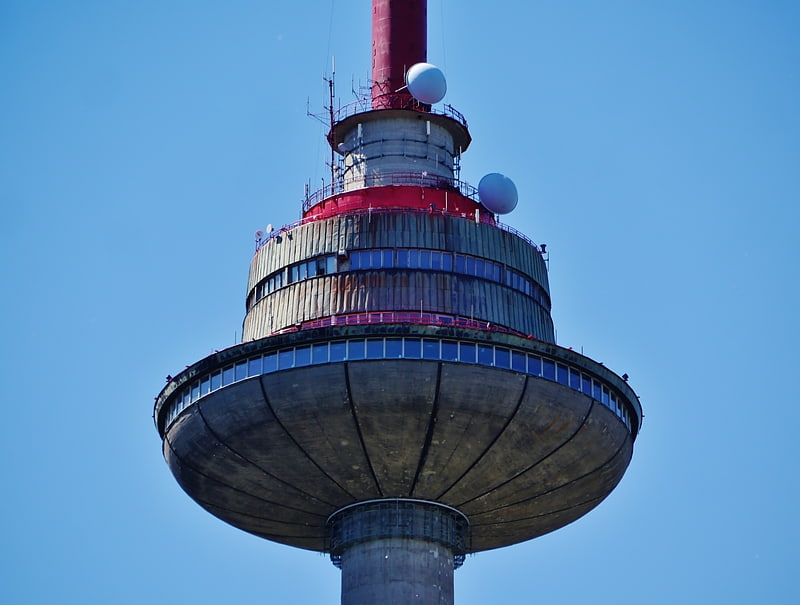
Also known as: Vilniaus televizijos bokštas
TV tower with an observation deck and cafe. The Vilnius TV Tower is a 326.5 m high tower in the Karoliniškės microdistrict of Vilnius, Lithuania. It is the tallest structure in Lithuania, and it belongs to the SC Lithuanian Radio and Television Centre.[10]
Address: Sausio 13-osios g. 10, 04347 Vilnius
St. Anne's Church
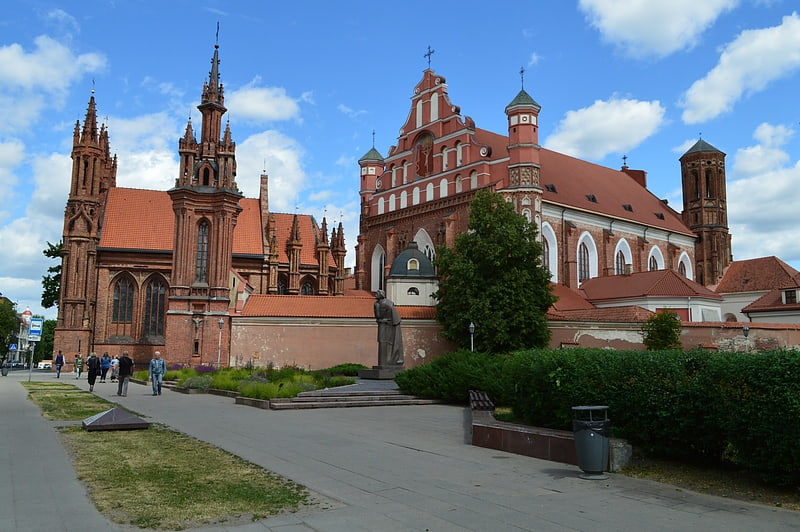
Also known as: Vilniaus Šv. Onos bažnyčia
Gothic, 16th-century Catholic church. St. Anne's Church is a Roman Catholic church in Vilnius' Old Town, on the right bank of the Vilnia River established circa 1495–1500. It is a prominent example of both Flamboyant Gothic and Brick Gothic styles. St. Anne's is a prominent landmark in the Old Town of Vilnius that enabled the district to be included in the list of UNESCO World Heritage sites, and is one of the most interesting examples of Gothic architecture in Lithuania.[11]
Address: Maironio g. 8, 01124 Vilnius
Akropolis
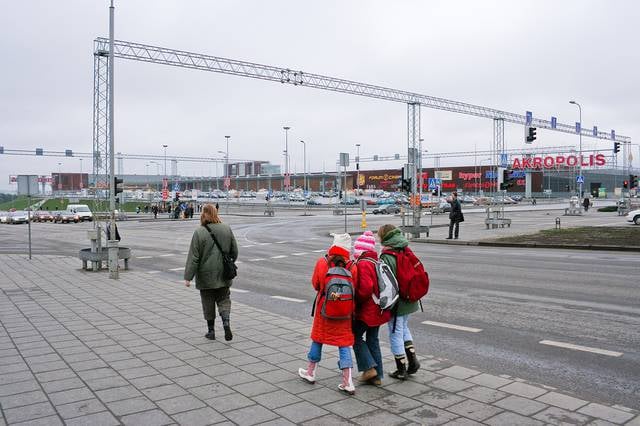
Shopping mall. Akropolis is the largest shopping mall in the Baltics by floor area, a shopping center and entertainment center in Vilnius, the Lithuanian capital. It was built in Šeškinė by Akropolis Group in 2002 and opened in April 2002. The bank "Hansa-LTB" financed the construction. The authors of the project "Akropolis" were architects Gediminas Jurevičius and Algimantas Nasvytis from Vilnius. Interior project author was designer Unko Kunnap.
There is a free car park next to the building. In Akropolis there are grocery stores, Maxima LT supermarket, shops etc. The shopping center also has a bookstore. The area has an area of 110,000 square meters. Not far away is the other shopping center, PC Ozas, built by German companies.[12]
Address: Ozo g. 25, 07150 Vilnius
National Museum of Lithuania
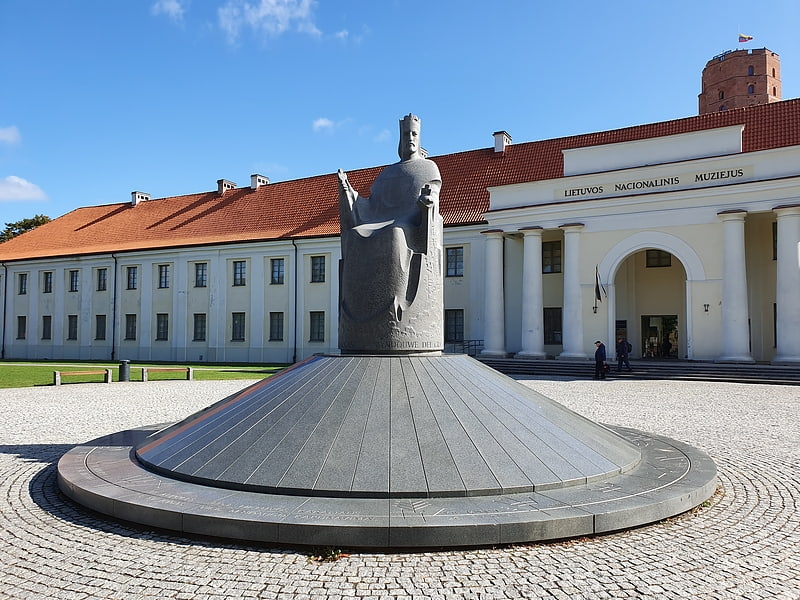
Also known as: Lietuvos nacionalinis muziejus
Museum in Vilnius, Lithuania. The National Museum of Lithuania, established in 1952, is a state-sponsored historical museum that encompasses several significant structures and a wide collection of written materials and artifacts. It also organizes archeological digs in Lithuania.[13]
Address: Arsenalo Str. 1, Vilnius
Cathedral Square
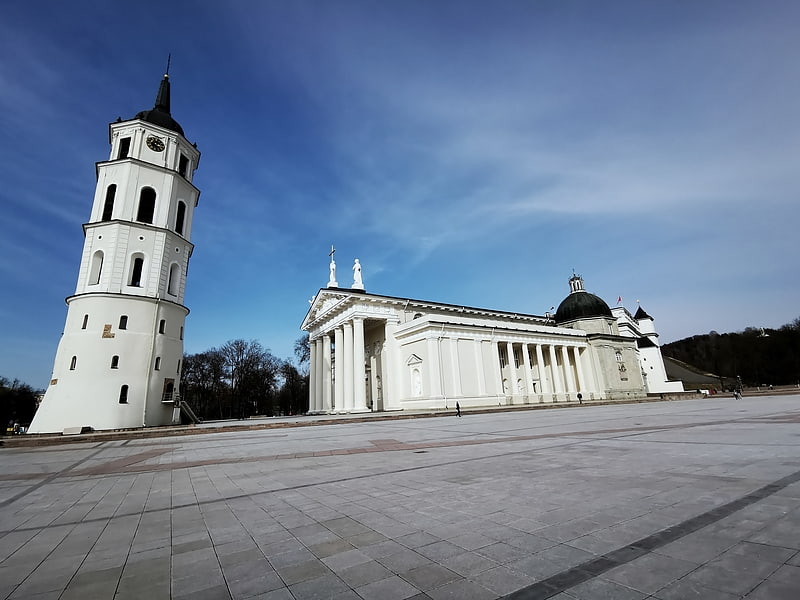
Also known as: Katedros aikštė
Tourist attraction in Vilnius, Lithuania. The Cathedral Square in Vilnius is the main square of the Vilnius Old Town, right in front of the neo-classical Vilnius Cathedral. It is a key location in city's public life, situated as it is at the crossing of the city's main streets and reflecting the city's diversity. Regularly held at this site are fairs and gatherings of townspeople, military parades, religious and official public events, attractions and large concerts, New Year’s salutes and exhibitions. It is not merely the most lively and important location in the city, but is also one of the most significant and widely known symbols of Lithuania.[14]
Museum of Genocide Victims
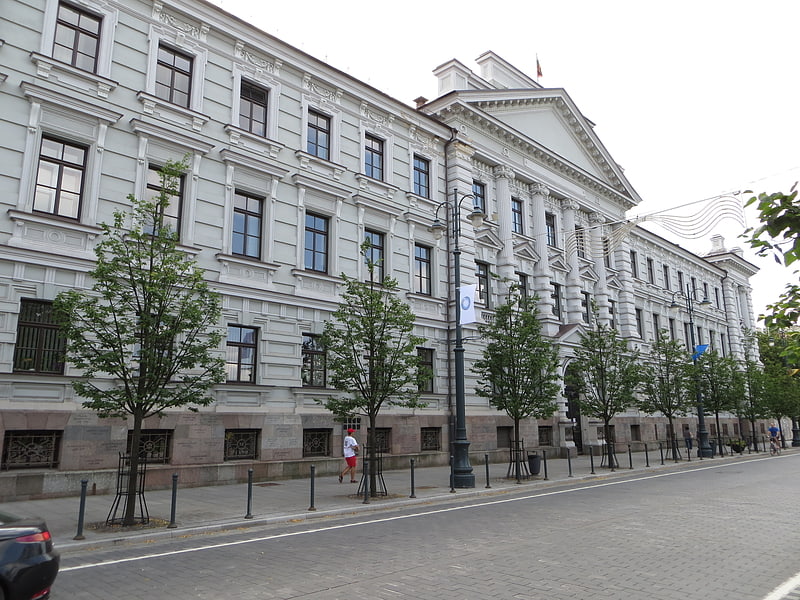
Also known as: Okupacijų ir laisvės kovų muziejus
Museum dedicated to murdered Lithuanians. The Museum of Occupations and Freedom Fights in Vilnius, Lithuania, was established in 1992 by order of the Minister of Culture and Education and the president of the Lithuanian Union of Political Prisoners and Deportees. In 1997, it was transferred to the Genocide and Resistance Research Centre of Lithuania. The museum is located in the former KGB headquarters across from the Lukiškės Square and is informally referred to as the KGB Museum.
The museum is dedicated mostly to collecting and exhibiting documents relating to the 50-year occupation of Lithuania by the Soviet Union, the anti-Soviet Lithuanian partisans, and the victims of the arrests, deportations, and executions that took place during this period. Before 2018, the museum was known as the Museum of Genocide Victims, reflecting a broadened definition of the genocide used by the Genocide and Resistance Research Centre. Although these events are considered a genocide only by a few historians, just a small part of the space is devoted to the Holocaust in Lithuania, the event that is universally considered a genocide. In 2018, the museum was renamed the Museum of Occupations and Freedom Fights.[15]
Address: Auku g. 2A, 01113 Vilnius
Slushko Palace

Also known as: Sluškų rūmai
Palace in Vilnius. Slushko Palace in Vilnius, Lithuania is a Baroque palace situated on the left bank of Neris River in the Old Town elderate, former Antakalnis suburb of the city.
The palace was erected in 1690–1700 by voivode of Polock Dominik Słuszko of the Clan of Ostoja, who ordered creating an artificial peninsula on Neris for the purpose of building the palace there. The peninsula was formed from the soil of the leveled down hill separating Antakalnis from the Vilnius Castles. Initially the façades of the palace were unified by a giant order of Ionic pilasters framing huge windows. It is believed that the decoration works of the palace were performed by Michelangelo Palloni and Giovanni Pietro Perti who was the architect of the palace.
The Polish–Lithuanian rulers used to stay in the palace during their visits in the city after the Royal Palace was damaged. The Russian tsar Peter the Great stayed and had his headquarters established here in 1705 and 1709.
After Słuszko's death the palace was owned by the Puzyna princely family (of Rurikid stock) since 1727 and by the Potocki family since 1745. The Piarist monks bought the palace in 1756 and established a collegiate and a printing house. Later it was bought by Michał Kazimierz Ogiński in 1766 and reconstructed by Pietro Rossi. The palace was confiscated by the tsarist government in 1794 and transformed into an apartment house. It housed a brewery of Dominik Zajkowski from 1803 until 1831 when the palace was taken by tsarist military. The building was rearranged, the floors were redivided into four, and the palace served as a military prison since 1872. The rich original interior and exterior of the palace have not survived.
Nowadays the palace houses the Lithuanian Academy of Music and Theatre. In the meantime the outhouses are undergoing the restoration and the main palace is planned to come next. The palace is planned to regain its original two main floors layout and original Baroque style windows.[16]
Address: 10 T. Kosciuškos g, Vilnius
Liepkalnis
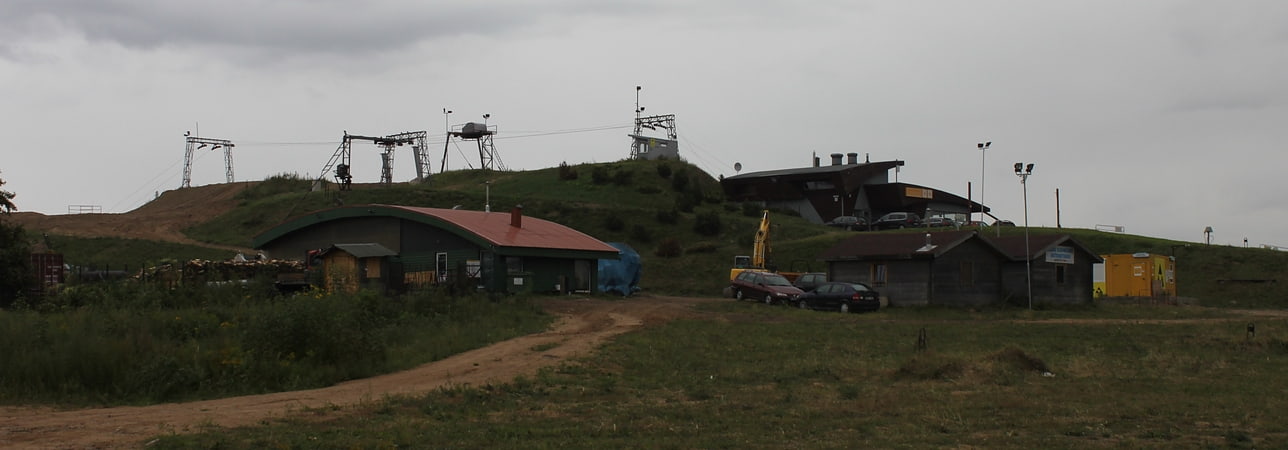
Liepkalnis Winter Sports Centre is an alpine skiing area in Vilnius, Lithuania. It has 10 lifts and 9 groomed ski runs. All the pistes are lit and equipped with artificial snow making equipment. The centre is based on the highest point in Vilnius, Laimio kalnas, with a maximum altitude of 235.12 metres above sea level. The maximum altitude difference on the hill is 65 metres.[17]
Address: Minsko pl. 2, 02121 Vilnius
Palace of the Grand Dukes of Lithuania
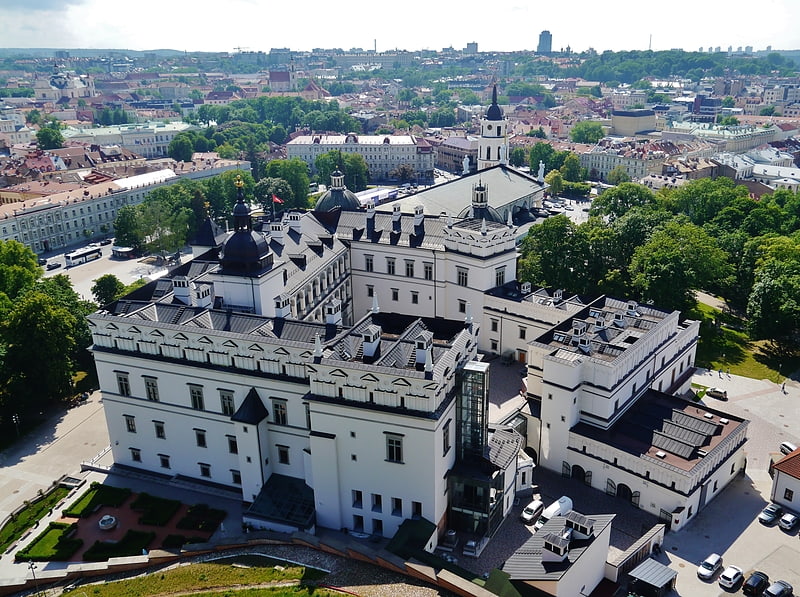
Also known as: Lietuvos didžiųjų kunigaikščių rūmai
Art and history exhibits in a palace. The Palace of the Grand Dukes of Lithuania is a palace in Vilnius, Lithuania. It was originally constructed in the 15th century for the rulers of the Grand Duchy of Lithuania and the future Kings of Poland. The palace, located in the lower castle of Vilnius, evolved over the years and prospered during the 16th and mid-17th centuries. For four centuries the palace was the political, administrative and cultural centre of the Polish–Lithuanian Commonwealth. It was demolished in 1801. Work on a new palace started in 2002 on the site of the original building and it took 16 years to complete it in 2018. The palace was rebuilt in Renaissance style to match the Cathedral of Vilnius and, according to the testimony of one of the couriers of Grand Duchess Bona Sforza, such initial reconstruction from 1520 to 1530 cost 100,000 gold ducats and was ordered by Grand Duke Sigismund I the Old. It is believed that the reconstruction was made for the proclamation ceremonies of Sigismund II Augustus, the only son of Sigismund I the Old, as the Grand Duke of Lithuania.[18]
Address: Katedros a. 4, 01143 Vilnius
Seimas Palace

Also known as: Seimo rūmai
Seimas Palace is the seat of the Seimas, the Lithuanian parliament. It is located in Lithuania's capital Vilnius.[19]
White Bridge
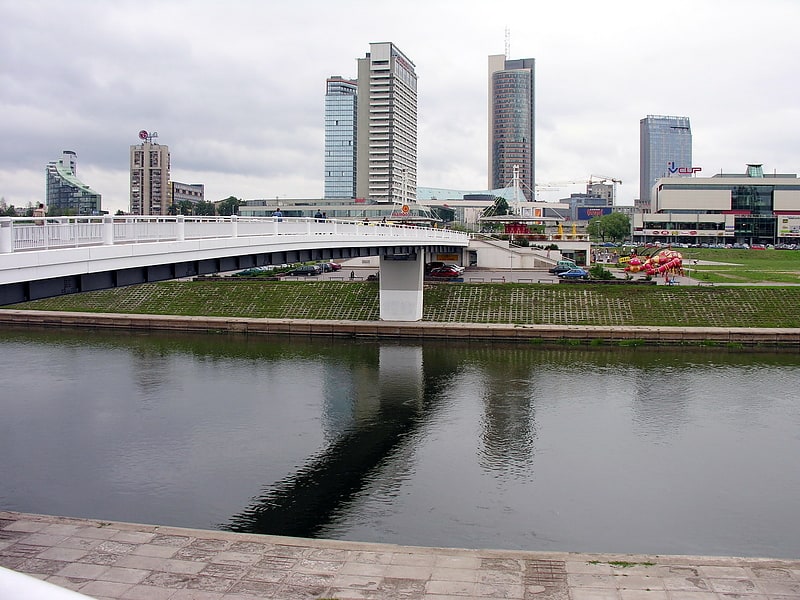
The White Bridge is a pedestrian bridge over the Neris River in Vilnius, Lithuania, that connects Naujamiestis with the district of Šnipiškės. The bridge was built in 1996.[20]
Green Bridge

Also known as: Žaliasis tiltas
Bridge in Vilnius, Lithuania. The Green Bridge is a bridge over the Neris River in Vilnius, Lithuania, that connects the city center with the district of Šnipiškės. The original 16th-century bridge was the oldest bridge in Vilnius.[21]
Address: Kalvarijų g. 1, Vilnius
Cathedral of the Theotokos

Also known as: Vilniaus Dievo Motinos Ėmimo į Dangų katedra
Orthodox church in Vilnius, Lithuania. The Cathedral of the Theotokos in Vilnius is the episcopal see of the Eastern Orthodox Christian Metropolitan of Vilnius and all Lithuania.
In 1415 – 1795 it was a cathedral temple metropolitan bishops of Kiev of the Ruthenian Orthodox Church and the Ruthenian Uniate Church (following the 1596 Union of Brest) within the Polish–Lithuanian Commonwealth.[22]
Address: Maironio St.,14, 10201 Vilnius
Lithuanian National Drama Theatre
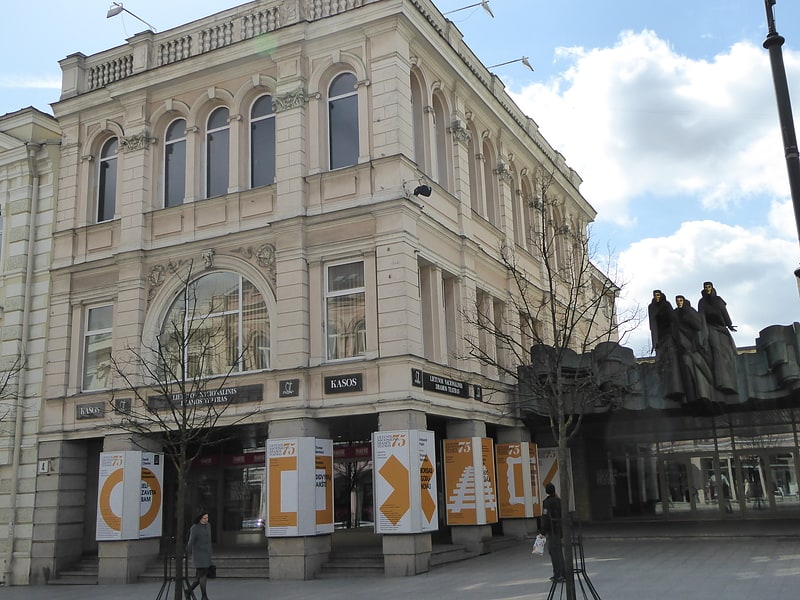
Also known as: Lietuvos nacionalinis dramos teatras
Theatre in Vilnius, Lithuania. Lithuanian National Drama Theatre, located on Gediminas Avenue in Vilnius, is one of Lithuania’s most prominent publicly funded performing arts venues and cultural institutions. Founded as a Vilnius State Theatre in 1940, it became Lithuanian National Drama Theatre in 1998. The theatre’s façade featuring the Feast of Muses sculpture has become a landmark of Vilnius city.[23]
Address: Odminių g., Vilnius
City Hall
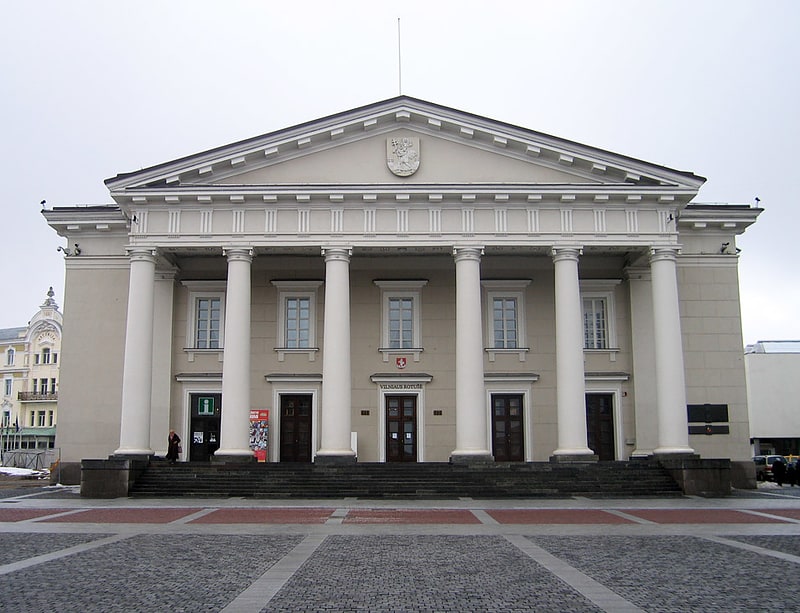
Also known as: Vilniaus rotušė
City or town hall in Vilnius, Lithuania. Vilnius Town Hall is a historical town hall in the square of the same name in the Old Town of Vilnius, Lithuania.[24]
Address: 31 Didžioji g, Vilnius
Lithuanian Theater

Lithuanian Theater, Music and Cinema Museum is a museum in Vilnius, Lithuania. It is located in the Minor Radvilos Palace. The material stored in the Museum reflects life, creation, and spiritual experience of Lithuanian artists. The Museum accumulates, preserves and examines showpieces related to the history of Lithuanian theatre, music, and cinema, organize evenings in commemoration of artists of these spheres, and exhibitions of collections, conducts exhaustive topical excursions and educational programs, prepare educational publications and consult visitors. Communicating with foreign institutions, international exhibitions are also held there to present significant artists of foreign countries. Furthermore, modern art exhibitions are held there, and summers are especially rich with various events in the amphitheatre of the Museum.[25]
Address: 41 Vilniaus g., Vilnius
Orthodox Church of the Holy Spirit
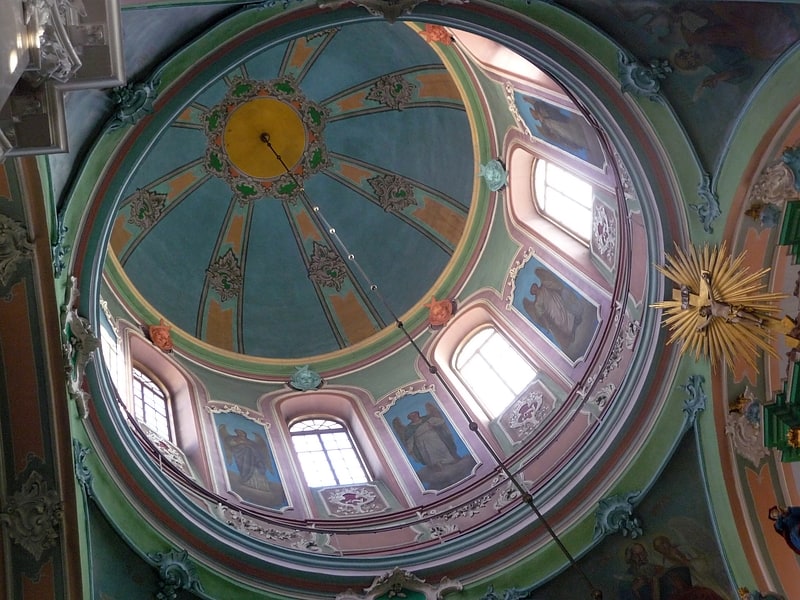
Also known as: Vilniaus Šv. Dvasios vienuolyno katedra
Orthodox church in Vilnius, Lithuania. The Orthodox Church of the Holy Spirit is a Russian Orthodox church in Vilnius, capital of Lithuania, rebuilt 1749–1753 in the Vilnian Baroque style. It should not be confused with the Roman Catholic Church of the Holy Spirit in Vilnius.[26]
Address: Aushros Vartu g. 10, 01303 Vilnius
Vileišis Palace

Also known as: Vileišių rūmai
Palace in Vilnius, Lithuania. Vileišis Palace is a Neo-baroque style architectural ensemble in Vilnius, Lithuania, built for Petras Vileišis. Vileišis was a prominent Lithuanian engineer, political activist, publisher, and philanthropist who commissioned the palace in 1904 and supervised its construction. The ensemble consists of a main house, a guesthouse, and an outbuilding. It currently houses the Institute of Lithuanian Literature and Folklore. It was renovated during the early 2000s.[27]
Church of St. Raphael the Archangel
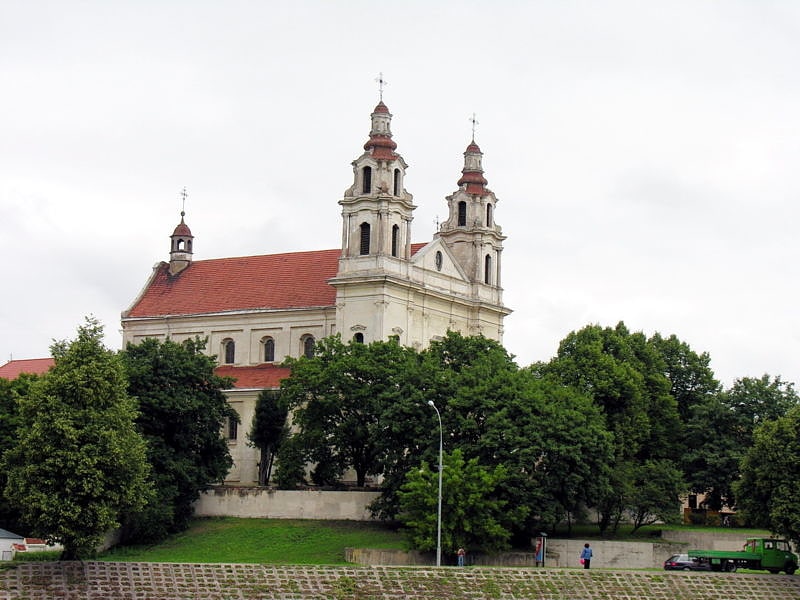
Church of St. Raphael the Archangel is a Roman Catholic church in Šnipiškės, Vilnius. Former Jesuits monastery ensemble is located nearby which currently is used by the Department of Cultural Heritage of Lithuania.
Close to the church there was a wayside shrine, containing a statue of Christ Carrying the Cross. The shrine was built around 1710 during the Great Northern War plague outbreak in Vilnius.
On 14 August 1904, the first President of the independent Lithuania Antanas Smetona married with Sofija Smetonienė in the Church of St. Raphael.[28]
Address: 1 Šnipiškių g, Vilnius
Vilnius city municipality building
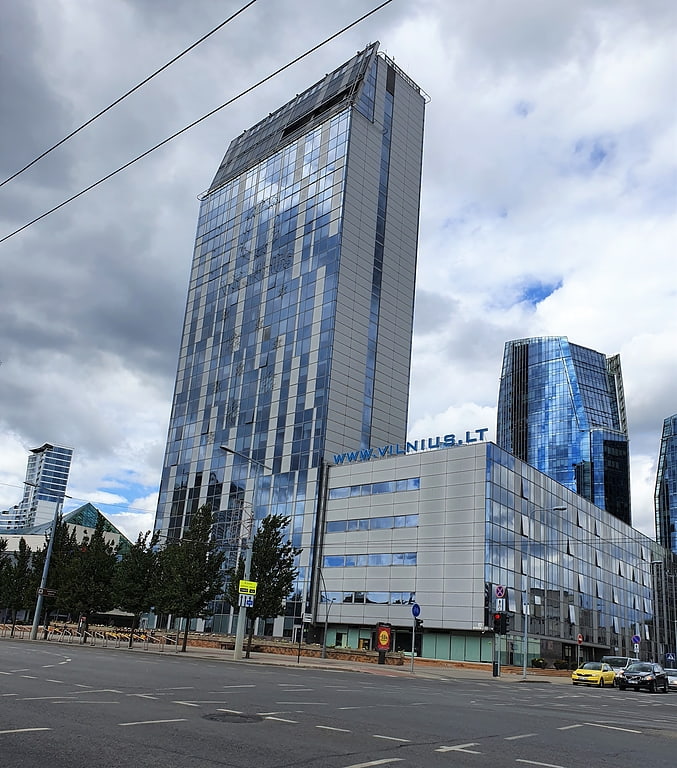
Vilnius City Municipality Building is located on Konstitucijos Avenue, Vilnius. The building was completed and opened in 2004. In the past, Municipal Departments and Divisions were scattered throughout the capital. Now they are concentrated in the new center of the Municipality, which has improved the service of the city residents and the working conditions of the municipal employees.[29]
Address: 3 Konstitucijos pr., Vilnius
Antakalnis Cemetery

Also known as: Antakalnio kapinės
Cemetery in Vilnius, Lithuania. Antakalnis Cemetery, sometimes referred as Antakalnis Military Cemetery, is an active cemetery in the Antakalnis district of Vilnius, Lithuania. It was established in 1809.[30]
Address: Kariu Kapu g. 11, 10313 Vilnius
Mindaugas Bridge
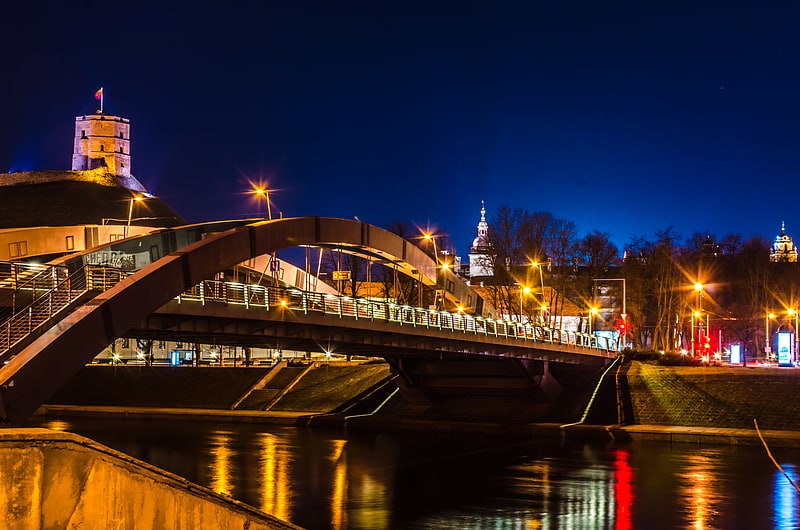
Also known as: Karaliaus Mindaugo tiltas
Arch bridge in Vilnius, Lithuania. The Mindaugas Bridge is a bridge in Vilnius, Lithuania. It crosses Neris River and connects Žirmūnai elderate with the Old Town of Vilnius. The bridge was named after Mindaugas, King of Lithuania, and was opened in 2003 during the celebrations of the 750th anniversary of Mindaugas' coronation. The bridge is 101 metres in length and 19.7 metres in width.[31]
Gediminas Tower
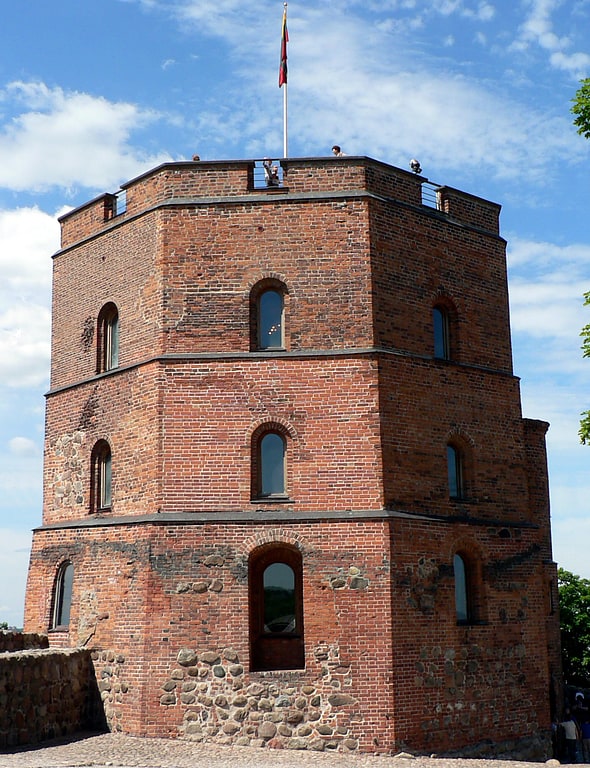
Also known as: Gedimino pilis
3-story 15th-century brick tower. Gediminas' Tower is the remaining part of the Upper Castle in Vilnius, Lithuania.
The first wooden fortifications were built by Gediminas, Grand Duke of Lithuania. The first brick castle was completed in 1409 by Grand Duke Vytautas. The three-floor tower was rebuilt in 1933 by Polish architect Jan Borowski. Some remnants of the old castle have been restored, guided by archaeological research.
The hilltop can be reached on foot or by lift. The tower houses a museum exhibiting archaeological findings from the hill and the surrounding areas. This building is 3 stories tall and is made of decades old bricks. The museum has models of Vilnius castles from the 14th to the 17th centuries, armament, and iconographic material of the Old Vilnius.
Gediminas' Tower is an important state and historic symbol of the city of Vilnius and of Lithuania itself. It was depicted on the former national currency, the litas, and is mentioned in numerous Lithuanian patriotic poems and folk songs. The flag of Lithuania was re-hoisted atop the tower on October 7, 1988, during the independence movement that was finalized by the Act of the Re-Establishment of the State of Lithuania on March 11, 1990.
A reconstruction of the Royal Palace of Lithuania was completed in 2009, and is located near the base of the hill upon which Gediminas' Tower stands.[32]
Address: Arsenalo g. 3, 01143 Vilnius
Church of St. Casimir
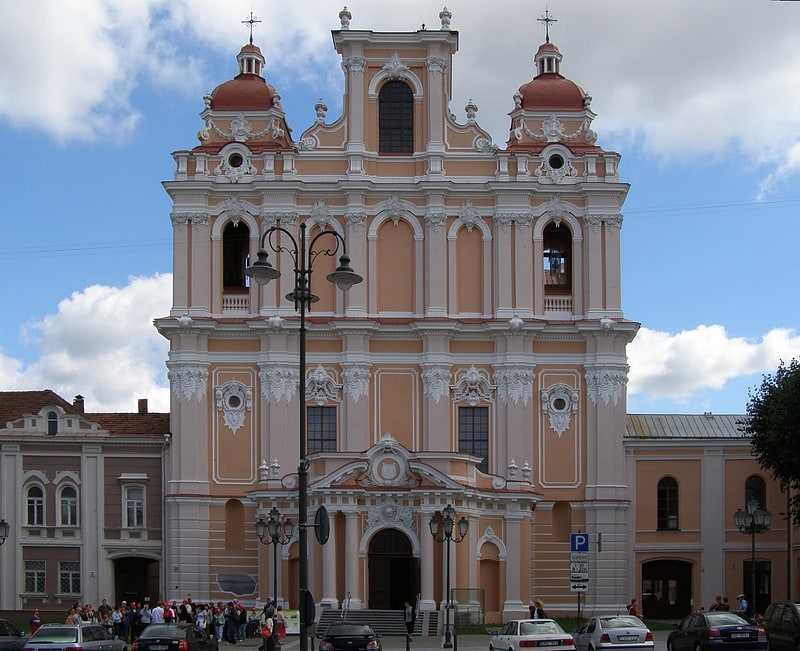
Also known as: Vilniaus Šv. Kazimiero bažnyčia
Building. The Church of St. Casimir is a Roman Catholic church in Vilnius' Old Town, close to the Vilnius' Town Hall. It is the first and the oldest baroque church in Vilnius, built in 1618.
The construction of the church began in 1604 in memory of the holy prince Saint Casimir. It was built by the Jesuits with funding by the Great Chancellor of the Grand Duchy of Lithuania Lew Sapieha, Voivode of Vilnius Mikołaj Krzysztof "the Orphan" Radziwiłł, and other nobles. It is traditionally assumed that the corner stone (which can be seen on the façade wall) was pulled into the city by procession of 700 Vilniusites from the Antakalnis hills. The construction was finished in 1616, and the interior design completed in 1618.
The Church of St. Casimir is one of the earliest exemplary Baroque buildings in the city. Its spatial composition and facade were designed along the line of the famous Il Gesù church in Rome. The shape of the building was modeled after the churches in Kraków and Lublin, with additional towers. The author of the design was Jan Frankiewicz, a pupil of architect Giovanni Maria Bernardoni.
In the middle of the 18th century the church was reconstructed by architect Thomas Zebrowski. Under his supervision a stepped lantern cupola with a crown was erected. This large and impressive cupola is unique in the entire region of the former Grand Duchy of Lithuania. Under Russia's occupation the church of St. Casimir was converted into a Russian Orthodox church. In 1915 Vilnius was occupied by the Germans and the church was converted into the Evangelical Lutheran prayer house of the Vilnius Garrison. In 1919 the church of St. Casimir was returned to the Catholics, but was damaged again during the Second World War, closed down and in 1963 converted into a Museum of Atheism. The church was reconsecrated in 1991.
The church is known for excellent acoustics and organ concerts with renowned international musicians.[33]
Address: Didžioji g. 34, 01128 Vilnius
Basilian Monastery in Vilnius
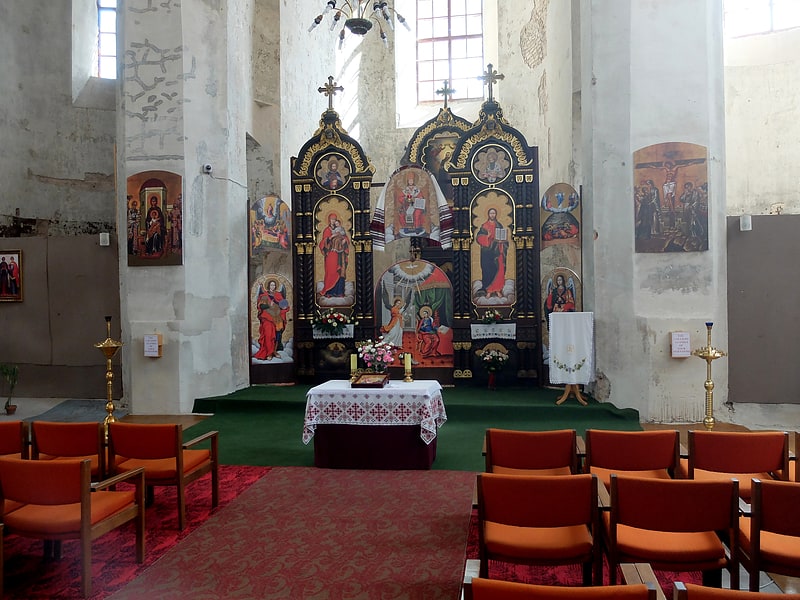
Also known as: Vilniaus Švč. Trejybės Graikų apeigų katalikų bažnyčia
Catholic church in Vilnius, Lithuania. Monastery of the Holy Trinity is a monastery built in Vilnius by the Ruthenian Uniate Church and Grand Hetman of Lithuania Konstanty Ostrogski as a thanksgiving to the God for the victory in Battle of Orsha. It belongs to the Order of Saint Basil the Great and the Ukrainian Greek Catholic Church.
The church is dedicated to the Holy Trinity. Beside this church, the monastery compound contains a fortified entrance gate, a university, a hotel complex for visitors, monastic cells including the Konrad's cell. The church is surrounded by adjoining four towers at each corner.
This monastery is associated with the Union of Brest personalities like Josaphat Kuntsevych, Archbishop of Polatsk who took vows here and spent first years of his monastic life, as well as a prominent reformer of the Basilian Order, Veliamyn Rutsky.[34]
Address: Aušros Vartų g. 7b, Vilnius
Sapieha Palace
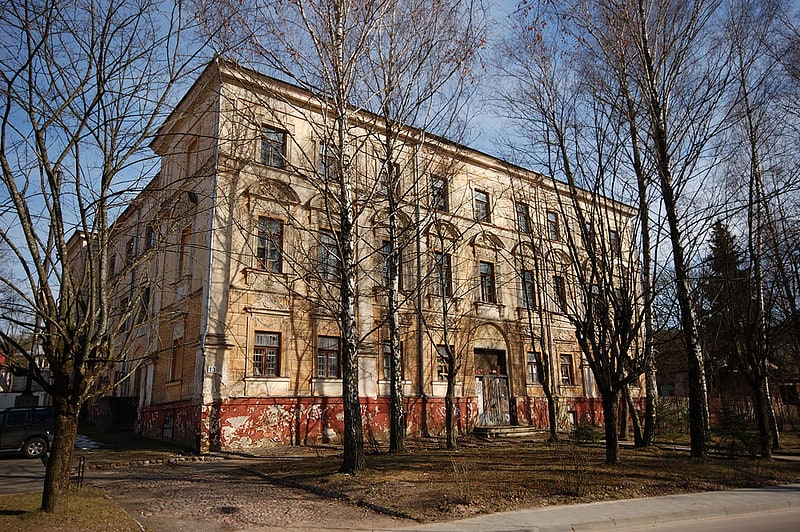
Also known as: Sapiegų rūmai
Palace in Vilnius, Lithuania. Sapieha Palace is a High Baroque palace in Sapiegos str. Antakalnis district of Vilnius, Lithuania. It is the only surviving of several palaces formerly belonging to the Sapieha family in the city. The palace is surrounded by the remains of the 17th-century formal park, with parterres, ponds, and avenues. The impressive Baroque gate secures the entrance to the park from Antakalnis street and the other gate is on the opposite side of the park, near the palace. Both of them were restored in 2012.[35]
Address: Sapiegos str, Vilnius